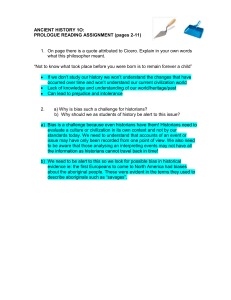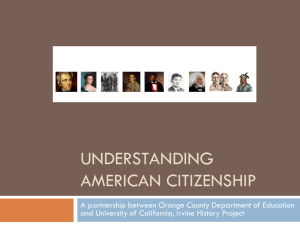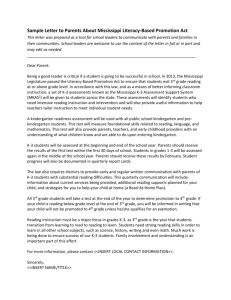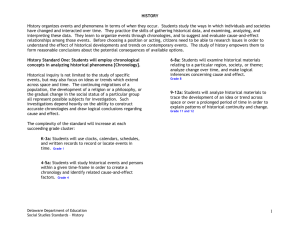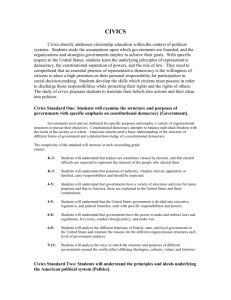HISTORY
advertisement
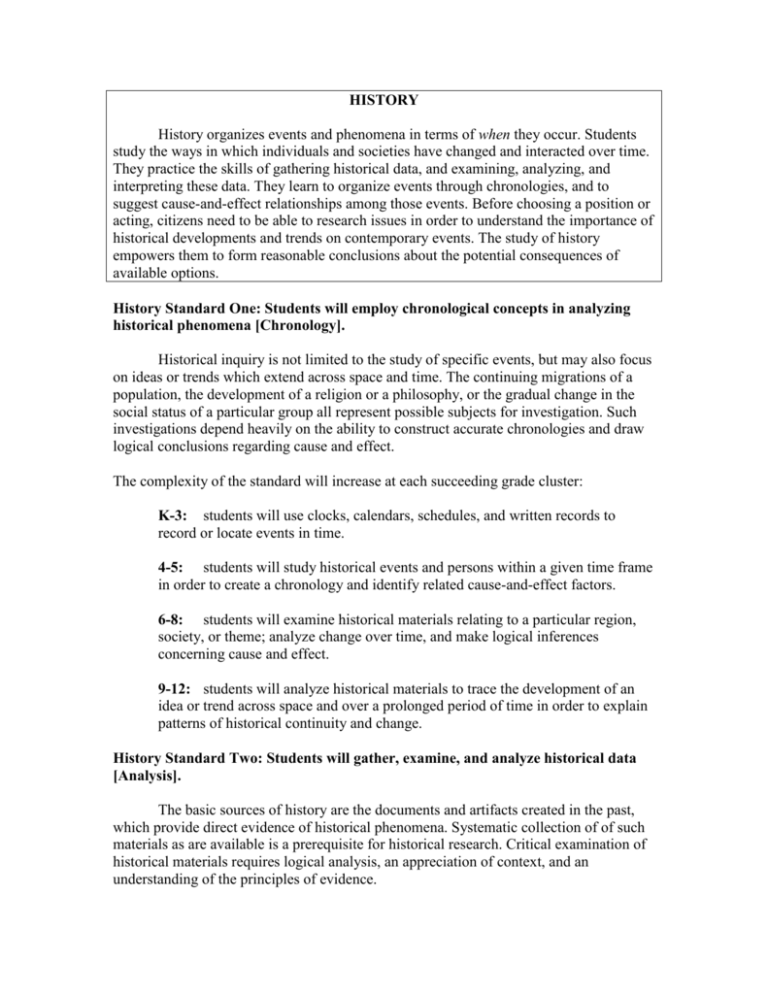
HISTORY History organizes events and phenomena in terms of when they occur. Students study the ways in which individuals and societies have changed and interacted over time. They practice the skills of gathering historical data, and examining, analyzing, and interpreting these data. They learn to organize events through chronologies, and to suggest cause-and-effect relationships among those events. Before choosing a position or acting, citizens need to be able to research issues in order to understand the importance of historical developments and trends on contemporary events. The study of history empowers them to form reasonable conclusions about the potential consequences of available options. History Standard One: Students will employ chronological concepts in analyzing historical phenomena [Chronology]. Historical inquiry is not limited to the study of specific events, but may also focus on ideas or trends which extend across space and time. The continuing migrations of a population, the development of a religion or a philosophy, or the gradual change in the social status of a particular group all represent possible subjects for investigation. Such investigations depend heavily on the ability to construct accurate chronologies and draw logical conclusions regarding cause and effect. The complexity of the standard will increase at each succeeding grade cluster: K-3: students will use clocks, calendars, schedules, and written records to record or locate events in time. 4-5: students will study historical events and persons within a given time frame in order to create a chronology and identify related cause-and-effect factors. 6-8: students will examine historical materials relating to a particular region, society, or theme; analyze change over time, and make logical inferences concerning cause and effect. 9-12: students will analyze historical materials to trace the development of an idea or trend across space and over a prolonged period of time in order to explain patterns of historical continuity and change. History Standard Two: Students will gather, examine, and analyze historical data [Analysis]. The basic sources of history are the documents and artifacts created in the past, which provide direct evidence of historical phenomena. Systematic collection of of such materials as are available is a prerequisite for historical research. Critical examination of historical materials requires logical analysis, an appreciation of context, and an understanding of the principles of evidence. The complexity of the standard will increase at each succeeding grade cluster: K-3: past. students will use artifacts and documents to gather information about the 4-5: students will identify artifacts and documents as either primary or secondary sources of historical data from which historical accounts are constructed. 4-5: students will examine historical materials relating to a particular region, society, or theme; chronologically arrange them, and analyze change over time. 6-8: students will master the basic research skills necessary to conduct an independent investigation of historical phenomena. 6-8: students will examine historical documents, artifacts, and other materials, and analyze them in terms of credibility, as well as the purpose, perspective, or point of view for which they were constructed. 9-12: students will develop and implement effective research strategies for investigating a given historical topic. 9-12: students will examine and analyze primary and secondary sources in order to differentiate between historical facts and historical interpretations. History Standard Three: Students will interpret historical data [Interpretation]. Historians collect and analyze both primary and secondary sources in order to describe, compare, and interpret historical phenomena. The same phenomenon or event may be presented from a variety of perspectives by different historians because they choose different questions to guide their inquiries, may have varied access to historical materials, analyze those sources differently, and are led by their own beliefs and points of view to weigh causes in distinct manners. Any comparison or evaluation of competing historical interpretations has to take these factors into account. The complexity of the standard will increase at each succeeding grade cluster. K-3: students will understand that historical accounts are constructed by drawing logical inferences from artifacts and documents. 4-5: students will explain why historical accounts of the same event sometimes differ and will relate this explanation to the evidence presented or the point-ofview of the author. 6-8: students will compare different historians’ descriptions of the same societies in order to examine how the choice of questions and use of sources may affect their conclusions. 9-12: students will compare competing historical narratives, by contrasting different historians’ choice of questions, use and choice of sources, perspectives, beliefs, and points of view, in order to demonstrate how these factors contribute to different interpretations. History Standard Four: Students will develop historical knowledge of major events and phenomena in world, United States, and Delaware history [Content]. An organized mental framework of events, people, trends, and other historical phenomena is essential to understanding, evaluating, and constructing historical interpretations. Such a framework allows us to draw logical inferences concerning the continuing impact of the past on the present. Individual periods, regions, or events should not be studied in isolation, but rather in comparison to one another. Nor should the broad sweep of events, or an emphasis on leaders, great works, and pivotal events obscure the importance of seeking to understand the everyday life of ordinary people in other times and places. The complexity of the standard will increase at each succeeding grade cluster: K-3: students will develop an understanding of the similarities between families now and in the past, including: --Daily life today and in other times --Cultural origins of customs and beliefs around the world K-3: students will develop an awareness of major events and people in United States and Delaware history. --Who lives here and how did they get here? (immigrants, demographics, ethnic and religious groups) --Important people in our past --Different kinds of communities in Delaware and the United States 4-5: students will develop an understanding of Delaware history and its connections with United States history, including: --Native American inhabitants before European contact --Exploration and settlement (1609-1775) --From the first state to the Civil War (1776-1865) --Growth of commerce, industry, transportation, and agriculture (1865-1945) --Modern Delaware (1945-present) 4-5: students will develop an understanding of selected themes in United States history, including: --Who are the American people? (demographics, immigration) --how did the United States develop its form of government? --How have advances in technology changed our lives? --Important people in American history 6-8: students will develop an understanding of pre-industrial United States history and its connections to Delaware history, including: --Three worlds meet (Beginnings to 1620) -- Colonization and settlement (1585-1763) --Revolution and the New Nation (1754-1820s) --Expansion and Reform (1801-1861) --Civil War and Reconstruction (1850-1877) 6-8: students will develop an understanding of ancient and medieval world history, and the continuing influence of major civilizations, including: --The beginnings of human society --Early civilizations and pastoral peoples (4,000-1,000 BC) --Classical traditions, major religions, and great empires (1,000 BC-300AD) --Expanding zones of exchange and encounter (300-1,000AD) --Intensified hemispheric interactions (1,000-1,500 AD)




